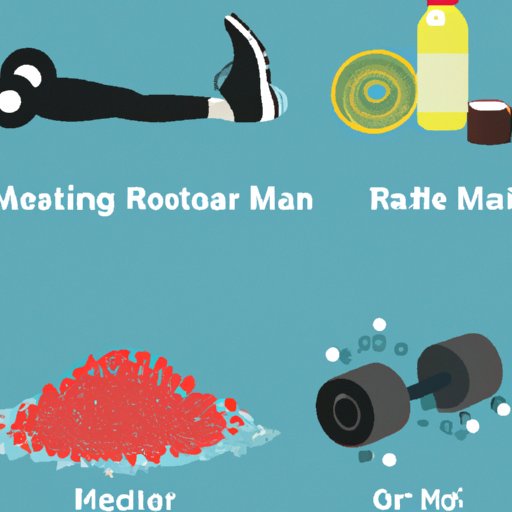Introduction
Soreness after working out is an extremely common experience. It’s caused by microtears in the muscles that occur during exercise, leading to inflammation and stiffness. While it’s normal to feel some soreness after a workout, if it becomes too intense or lasts for longer than a few days, it can be a sign of overtraining or poor recovery strategies. Fortunately, there are several ways to help reduce soreness after exercise.
Take a Cold Shower
A cold shower can be a great way to reduce post-workout soreness. According to research published in the International Journal of Sports Physical Therapy, cold showers have been shown to reduce muscle soreness and improve recovery time. This is because cold temperatures reduce inflammation and improve circulation, which helps to move toxins away from the muscles and reduce swelling.
Taking a cold shower isn’t as difficult as you might think. Start by turning the water to a comfortable temperature, then gradually lower the temperature until it’s cold. Make sure the water isn’t too cold, as this can shock your system and cause more harm than good. Aim for a temperature between 60-70 degrees Fahrenheit. Once you’re in the shower, focus the stream of water on the areas of your body that are most sore. You can also alternate between hot and cold water to maximize the benefits.
Use a Foam Roller
Using a foam roller is another effective way to reduce soreness after exercise. Foam rolling is a type of self-massage that helps to loosen tight muscles and improve circulation. According to research published in the Journal of Strength and Conditioning Research, foam rolling has been found to improve range of motion and reduce delayed onset muscle soreness (DOMS).
To use a foam roller, start by lying down on your back with the roller underneath your shoulders. Slowly roll your body forward and backward, focusing on any areas that feel particularly tight or sore. You can also use the roller to target specific areas of your body. For example, if your legs are feeling sore, place the roller under your thighs and roll up and down. You should apply enough pressure to feel a deep stretch but not so much that it causes pain.
Stretch After Working Out
Stretching is another important component of post-workout recovery. Stretching helps to improve flexibility, reduce tension in the muscles, and increase blood flow. According to research published in the journal Sports Medicine, regular stretching can help to reduce DOMS and improve recovery time.
When stretching, focus on dynamic stretches that involve moving parts of your body through a range of motion. Examples include hip circles, shoulder rolls, and arm swings. Hold each stretch for 10-30 seconds and repeat 2-3 times. If you’re feeling particularly sore, you can also try static stretches, which involve holding the stretch in one position without any movement. Just make sure not to overstretch or push yourself too hard.
Drink Plenty of Water
Drinking plenty of water is essential for post-workout recovery. Water helps to flush toxins out of the body and replenish electrolytes, which are lost during exercise. According to research published in the journal Nutrients, dehydration can lead to increased levels of DOMS, so it’s important to stay hydrated before, during, and after exercise.
The amount of water you should drink depends on your size and activity level. In general, aim to drink about 8-10 glasses of water per day. If you’re exercising for more than an hour, consider drinking a sports drink to replace lost electrolytes.
Get a Massage
Getting a massage is another great way to reduce post-workout soreness. Massages can help to improve circulation, reduce inflammation, and relax the muscles. According to research published in the journal PLoS One, massage has been found to reduce DOMS and improve recovery time.
If you don’t have access to a massage therapist, you can use a foam roller, tennis ball, or even a lacrosse ball to massage your own body. Apply gentle pressure to the area that’s feeling sore and use circular motions to massage the muscle. You can also use a massage stick or foam roller to massage larger areas of your body.
Eat Anti-Inflammatory Foods
Eating anti-inflammatory foods can also help to reduce post-workout soreness. Foods like salmon, chia seeds, and turmeric contain compounds that can help to reduce inflammation and speed up recovery. According to research published in the journal Nutrients, consuming anti-inflammatory foods can help to reduce DOMS and improve recovery time.
To get the most benefit from anti-inflammatory foods, try to incorporate them into your diet on a regular basis. Some examples include salmon, chia seeds, turmeric, ginger, leafy greens, walnuts, and blueberries.
Increase Your Magnesium Intake
Increasing your magnesium intake can also help to reduce post-workout soreness. Magnesium is an essential mineral that helps to regulate muscle contractions and reduce inflammation. According to research published in the journal Nutrients, magnesium supplements have been found to reduce DOMS and improve recovery time.
You can increase your magnesium intake by incorporating magnesium-rich foods into your diet. Some examples include spinach, almonds, cashews, black beans, avocado, and dark chocolate. You can also take a magnesium supplement to ensure you’re getting enough of the mineral.
Conclusion
Soreness after working out is a normal part of exercise, but if it becomes too intense or lasts for too long, it can be a sign of overtraining or poor recovery strategies. Fortunately, there are several ways to help reduce post-workout soreness, including taking a cold shower, using a foam roller, stretching, drinking plenty of water, getting a massage, eating anti-inflammatory foods, and increasing your magnesium intake. Remember to listen to your body and take the necessary steps to ensure proper recovery after exercise.
(Note: Is this article not meeting your expectations? Do you have knowledge or insights to share? Unlock new opportunities and expand your reach by joining our authors team. Click Registration to join us and share your expertise with our readers.)
